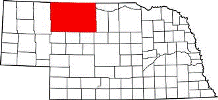Extension, Cooperative
Date of this Version
1935
Abstract
Throughout the year ending on November 16, 1935 extension work in Cherry County was administered cooperatively and sponsored by the following groups; namely, Board of County Commissioners; a County Extension Committee of seven members; a District AAA Wheat Control Association with headquarters at Ainsworth; a County AAA Corn-Hog Control Association, the Nebraska Resettlement Administration; and a tentative Farm Bureau organization.
Slightly less than one-half of the agents time was devoted to developing the AAA programs for the year. Somewhat less than one-fourth of his time was devoted to Emergency Drouth relief activities including the close of the cattle buying. The remainder of his time was devoted to general extension activities. These extension activities included promotion and developing of 4-H clubs, Clarke-McNary tree plantings, Pasture Improvement, Farm Records, Adult Womens Study Club and Home Demonstration Project clubs.
Previous to 1935 very little 4-H club work had been undertaken in this county. The records show ten members only, enrolled for 1934. The total enrollment for 1935 was 60 members in seven clubs. Two of these clubs completed the ten requirements necessary to win achievement seals. Thirty individual members of clubs have completed the work and have earned Achievement Certificates. At the close of the year seven clubs have enrolled 43 members for work which will be completed in 1936.
During 1935 a total of 32,200 Clarke-McNary seedlings were distributed to 37 cooperators in Cherry County. Of these seedling planted approximately 74% have survived the first season.
General bulletin service, including flock management has been extended Cherry County turkey growers. Plans for cooperative marketing have been outlined by mailings. Not enough information concerning the location of flocks is at hand to permit community demonstration work to be undertaken.
The 1934 drouth damage to ranges presented the opportunity for carrying on a limited educational program on range and grass land improvement. The details of a system of deferred and rotation grazing practiced by some of the successful ranchers were distributed as information to all cattlemen. A survey of cattle by precincts was taken to determine the number of cattle on a given acreage. This information was used to show why some ranges were standing up good and others were not feeding the cattle well. An exhibit of various specimens of grasses was started. This will be developed to show competition of poor types of grasses in overgrazed areas.
General assistance was given to all AAA signers with their record books. 648 records have been at least partly completed. Several have been completely and accurately maintained. More complete extension books are in the hands of a number who will complete records in order to get cost summaries prepared. The keeping of these records and their use for summary data will assist in farm management plans for the many visitors to the office requesting this service. Names of course will not be disclosed.
Information was distributed to assist in the control of local damage from cut worms and scattered damage from other insects. No serious infestations were reported for the year 1935. A late summer migration of grasshoppers indicates an expectation of some damage in 1936.
The office gave clerical assistance to local committees, assisting them in conducting the petitions and tabulations of signers requesting area test for Tuberculosis.
Prior to 1935 on Adult Study Group Club with an enrollment of 22 was reported from Cherry County. At the close of the year five such clubs are reported with a total membership of 116.
No Home Demonstration or Project club work had been attempted until this year. At the close of the year fifteen clubs have been organized. Five of these clubs were organized through Sheridan county office at Rushville. The remaining ten clubs were organized through the Valentine office and comprised of a total membership of 106.
During the winter months and until May 15, 1935 nearly one-half of the entire time of the agent was given to the drouth program. This work includied assistance given to the AAA cattle buying administration, the Farm Credit Administration, and to local feed and seed service. In addition to the organized emergency drouth programs the movement of feed as a service to buyers and sellers continued through the winter with the bulk of movement coming in April. The total value of feed for livestock for which information service was given to local buyers was estimated to be close to $51,980.00. During the spring planting season 8000 bushel of oats were shipped in from the seed stocks supplies. Approximately 6500 bushels of locally grown seen corn was listed with samples displayed and buyers found. 225 bushels of black amber cane seed locally grown near Marriman was brought into the Valentine trade territory. About 900 bushel of rye was moved from growers to those requesting the see.
Until the close of the year 1935 the AAA wheat contracts were administered from the District office at Ainsworth. 25 applications are on file for the new 1936-1939 wheat contract. Initial steps toward completing a program of 1936-1939 rye contracts are under way. Both wheat and rye contracts will be supervised through a Cherry County Grain Control Association with officers yet to be elected.
648 corn-hog contracts were transmitted to Washington for payment. These contracts transmitted represent a corn base of 69,536 acres and a contracted reduction of 20,597 acres. They represented a hog base of 25,826 hogs and a 1935 permitted production of not to exceed 23,892 head. Actual total acreage planted and a total production of hogs for market will be computed beginning December 2. Gross Benefit Payments totaled $166,033.95 as compared with $208,199.30 for the 1934 program. Administrative costs are estimated at $8100 as compared with $8550 for the 1934 year. The percentage cost is estimated to be slightly less than 5%. The cost per contract has been reduced approximately 55¢ per contract.



Comments
Courtesy Cherry County (Nebraska) Extension Office